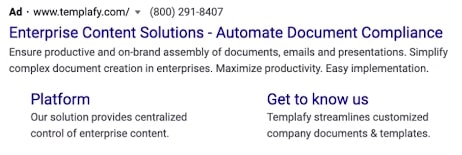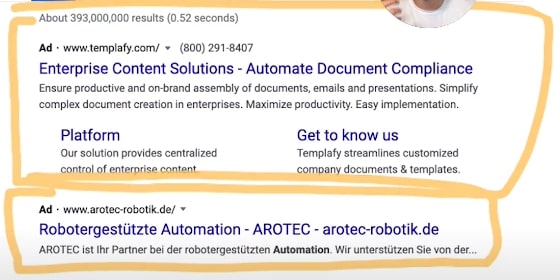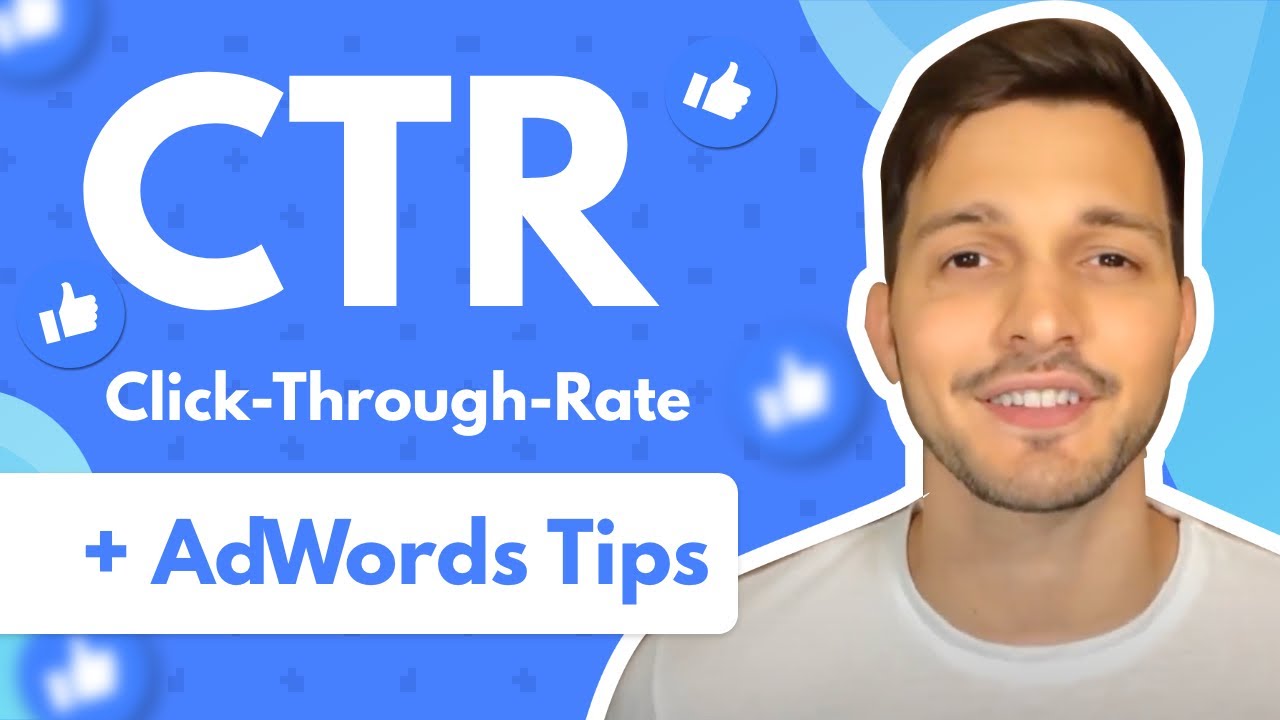Google Ads CTR (Click-Through-Rate) is one of your most important metrics, especially if you’re just starting out. It’s one of many KPIs that give you insight into where your campaign’s flaws are.
The problem is that a lot of marketers are ignorant as to what CTR is, how it’s calculated, and how to improve it. If this includes you then don’t worry. In this blog post, we’re going to explain all of those things so that you can get a better hold of your campaign and improve its performance ten-fold.
What is Google Ads CTR?
Basically, CTR is the percentage of people who see your ad and click on it. The reason this is an important metric is that it’s a huge factor in your Google Ads quality score.
Let’s be optimistic and say that 100 people saw your ad and 7 of them clicked on it. This means you have an impressive 7% CTR. Not only does this indicate to you that you’re doing something right, but Google uses this value to determine how relevant your ads are which is reflected in your quality score.
With a higher CTR you’ll actually be paying less CPC (Cost-Per-Click) prices than your competitors will. Why? Because Google recognizes that your ads are more relevant, they know that your ads are going to generate them more profit. Not only that but they’ll bump your ads above your competitor’s ads too, again due to that relevancy.
Of course, Google Ads CTR isn’t the only metric that Google takes into account. There’s also landing page experience and ad relevance, but CTR is one of the main indicators to keep an eye on.
What is a Good CTR for Google Ads?
This is an unpopular answer, but it depends. Industry is the biggest variable when gauging what a good CTR is – legal, for instance, has the lowest benchmark across all industries.
That being said, a good CTR to aim for is somewhere between 2-3%. If you’re in that territory then you’re doing a good job. When it comes to optimizing your campaign though, you’ll want to aim higher at around 4-5%, which is a really strong CTR to have.
Tips to Improve Google CTR
Now you know what CTR in Google Ads is and why it’s an important metric. Next, you need to know what steps can be taken to improve your CTR.
Focus on Your Ad Copy
Having high-quality ad copy goes a long way. Your copy needs to be enticing – get your readers’ attention and make them want to click on the ad. Another way you can improve your ad copy is with SKAGs (Single Keyword Ad Groups). Although SKAGs became less effective after Google’s close match variant update, they’re still a great way to organize your campaigns and get better results.
What you’d do in this case is simple. Just take the keyword and put it in your ad copy – that’s it. Why does this work? Imaging you’re a customer searching Google for fuzzy slippers (bear with us). Two ads are shown at the top of the results: one mentions women’s slippers, the other specifically mentions fuzzy slippers. Which one are you more likely to click on?
9 out of 10 times you’ll click on the fuzzy slippers ad because it’s exactly what you were searching for. We’ve got a video explaining SKAGs in more detail so be sure to give that a watch!
2. List Features in the Ad Copy
Straight away doing this gives potential customers an instant idea of what to expect from your product. They don’t have to click on your ad, they don’t have to search your website – they’re getting the key features without any hassle. In turn, this gets the customers who are more interested to click on your ad.
If you take the opposite approach and use ad copy that says, “We love our customers. 10 years in the industry. Nowhere does it better!”, or some other generic message, you’ll get less engagement. Going for, “Free shipping. Moneyback guarantee. 100% organically produced!”, gives you a huge leg up over your competitors since your copy is more informative and actually lists features that your customers are looking for.
This next part might seem strange considering we’re trying to improve Google Ads CTR, but in some cases you’ll want to decrease your CTR. Let’s say you’re in an industry with a crazy CPC (e.g. $25+), you’ll want to reduce the number of unqualified clicks you get. If you cut out a chunk of those unqualified clicks you’ll have a lower CTR, but your budget will be spent more efficiently.
How can you do this? By adding disqualifiers to the ad copy. For example, if you’re in the finance industry and don’t work with people below a certain credit score, mention that threshold in your ad copy. Anyone with a credit score below that threshold who sees your ad and would otherwise have clicked on it will stop in their tracks, decreasing your CTR but saving you an expensive click.
3. Do Competitor Research
Using PPC spy tools can help a lot with this, but competitor research is another great way to boost your Google Ads CTR. With these tools, you can find out what your competitors’ most profitable ads are and use them for inspiration. Figure out what they’re doing right and work that into your own ads strategy.
If you were to use SpyFu, for example, then you can see which keywords they’re repeatedly bidding on. When a company is consistently bidding on the same keywords, this is a great sign that those keywords are getting them solid results.
Sure, you could take on the research from scratch and start spending thousands to figure out what works on your own. But doing this is not just expensive, it’ll take you months of experimenting. Why reinvent the wheel?
We also did a video explaining competitor research in more depth, so if you want to get ahead of your competitors we’d recommend giving that a watch.
4. Run Ads on a Schedule
This will have a tremendous impact, especially if you’re in B2B. The fact is, very few businesses will benefit from running their ads at 4AM on a Sunday. Not many people are actively searching at those early hours and those who are probably aren’t seriously considering buying from you.
How can you counter this? Look at your analytics and see when your best performing hours are. When are you getting the best CTR and to go a step further, when are you getting the worst Google Ads CTR?
With this information you can put your ads on a schedule so that they’re only being shown at your best performing hours and so that your budget isn’t being wasted in the middle of the night. Your schedule will vary depending on the industry you’re in, but if we take B2B for example you’d want to run your ads between 7AM and 6PM (typical business hours).
All scheduling does is eliminate your worst performing hours and refocuses the campaign on when it runs best. If you only take one tip away from this post then let it be this one.
5. Use Ad Extensions
Forgetting to use ad extensions is one of the biggest Google Ads mistakes we see. Here are two examples to consider:

In this first example you can see that they’ve added page links as an ad extension, and in this second example you can see they have their phone number added.

The reason that these help increase your CTR on Google is that when you’re targeting mobile users, they’re less willing to actually click on the ad and go through your website to find out the information they need. Whereas if you include the links to the pages they need as ad extensions, they’re much more likely to click.
The same goes for the phone number as this uses tap-to-call. In other words, if a mobile user sees your ad, all they have to do is tap the number and they’ll call your business. This provides an effortless experience for the user and will bring your cost-per-call down a lot.

Take a look at this final example. Another benefit to using ad extensions is that it just makes your ad bigger. Look at the top ad and notice how much real estate it’s taking up, compared to the bottom ad which is less than half the size. Bigger ads are better at catching customers’ eyes.
Start Improving Google Ads CTR Today
Now you know what CTR is and how to improve your Google Ads CTR. The next step is to implement some of these strategies into your own campaign. Sure, it’ll take some time for these changes to reflect in your campaign’s performance, but the effects will be undoubtedly positive.
You don’t have to go at this alone though. Most of the time it can help to have a team of experts by your side and that’s where we come in. KonvertLab has plenty of experience as a Google Ads agency and can take your advertising efforts to the next level. Ready to grow? Book a call below and let’s get started.

